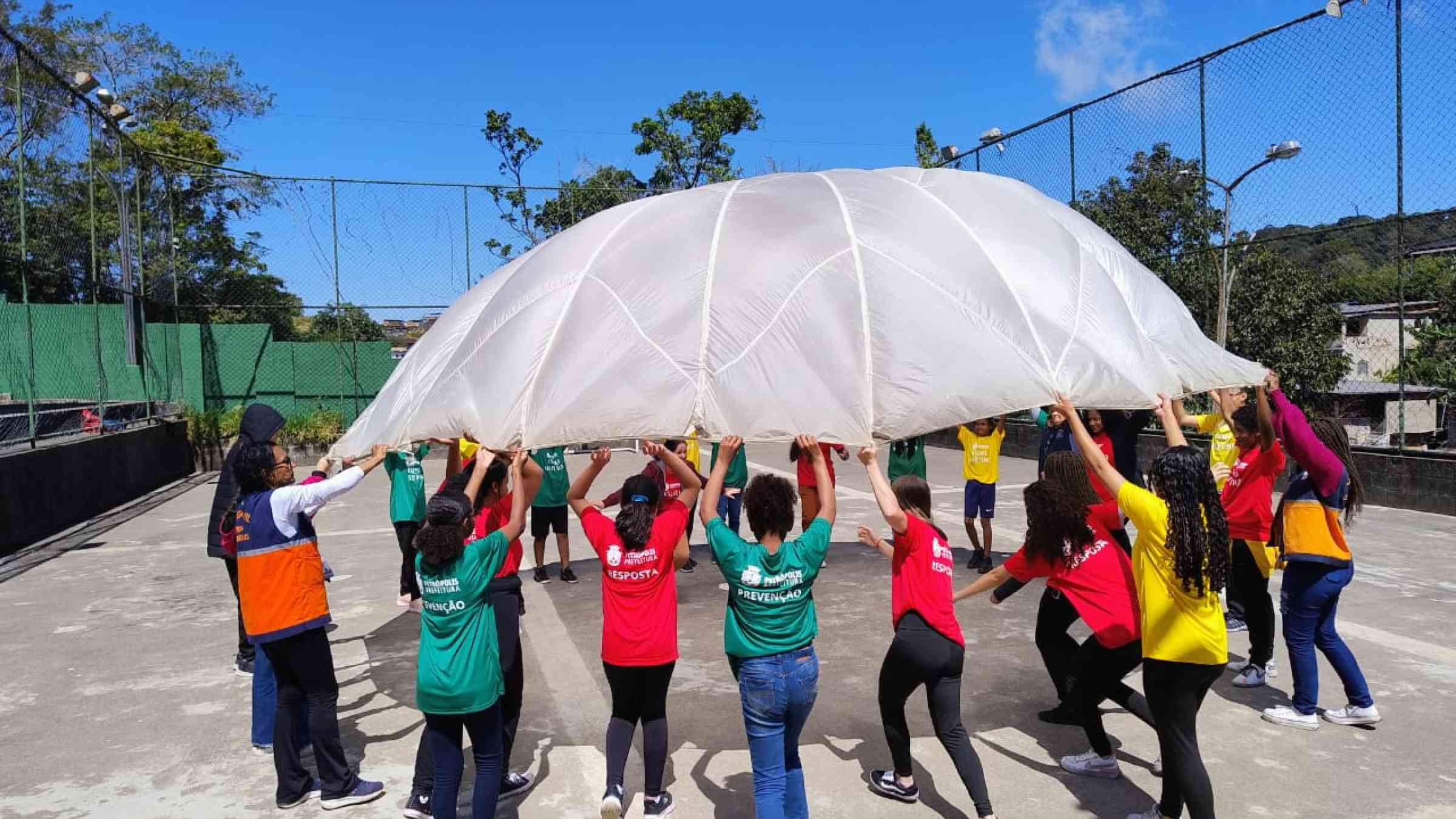Resilient Schools: Empowering Students in Brazil to Lead Disaster Risk Management and Build Safer Communities

Children walking with open umbrellas in a disaster risk prevention drill at a school in Petrópolis.
Formation of School Safety Committees: Purpose, Leadership, and Agency
The alarm whistles sound in the hallways of Rubens de Castro Bomtempo Municipal School. Immediately, groups of young people position themselves and organize into teams to carry out a simulated school evacuation to a safety area. While each classroom, already arranged in rows, waits for its turn to exit, another team positions itself in the hallways and staircases to prevent any blockage of the flow of people. The rows of students move through the hallways, following the arrows and signs along the way.
On each floor, a map with exit directions can be seen. Teachers, staff, and administration all follow the flows created by the teams and move to the safety area. Special attention is given to students in wheelchairs, those with autism, or other disabilities. All of this happens within minutes, and in a short time, the entire school body is in the safety area. The stopwatch records 2 minutes and 46 seconds until all 407 people in the building are in a safe area.
This school is one of the 51 Resilient Schools in the municipality of Petrópolis, where school-based risk management is practiced by the students themselves. They identify risks, diagnose vulnerabilities, and organize capabilities to form their School Safety Committees. These safety committees are divided into prevention, preparedness, and response teams to create emergency protocols, risk maps, and early warning systems.
The municipality of Petrópolis, located in the mountainous region of Rio de Janeiro, is considered the municipality with the highest number of socio-environmental disasters due to landslides and floods in the southeastern region of the country, according to the Digital Disaster Map in Brazil by the Ministry of Integration and Regional Development. This data alone is a strong motivation to develop a risk culture in the municipality, based on awareness and prevention, with the active participation of young citizens.
The missions and challenges that young people, teachers, and staff of the resilient schools face throughout the year are dynamic and related to local urban planning, the SDGs, Nature-Based Solutions (NBS), facilitating dialogues, and urban reforestation. This knowledge broadens the worldview of these young people and encourages innovation for regeneration. With this awareness, the Resilient Schools Program in the municipality of Petrópolis currently reaches 51 elementary schools.
The number of direct beneficiaries throughout the year is approximately 4,000 people, including students, staff, and teachers. In 2024, the prevention teams were encouraged to carry out seedling planting actions, reaching 1,100 seedlings in reforestation areas. Additionally, the preparedness teams made homemade rain gauges to measure the amount of rainfall in their territories, with 1,009 homemade rain gauges recorded in use.
In 2023, the Municipal Secretariat of Protection and Civil Defense, through the Resilient Schools, launched an intuitive school evacuation guide and invited all educational institutions in the municipality to participate. November 29th at 10 a.m. was designated as the day/time for the action. The participation of 149 educational institutions involved approximately 18,000 people in executing the school evacuation across the municipality.
This year, 2024, we expect even greater participation, with the involvement of private schools and universities in the city. All activities carried out by the Resilient School Program in schools in Petrópolis promote understanding and strengthen social capacity for resilience, which is one of the 10 essential steps of the MCR2030 Initiative to build a Resilient City. In practice, it promotes a plural education that invests in the leadership and capacity of young people and teachers to manage risk in the school in a collaborative and organized manner.
This learning process fosters the development of a risk culture, which is then amplified by these social actors in the communities where they live. The Resilient School Program supports and carries out activities mainly related to SDG 4 - Quality Education and SDG 11 - Sustainable Cities and Communities.
The Resilient Schools is an educational innovation in Brazil, and aims to contribute to increasing the capacity of municipalities like Petrópolis, which suffer from cyclical disaster situations, to develop increasingly integrated public policies between schools and their communities, fostering creative, innovative young people who are agents of social transformation.
